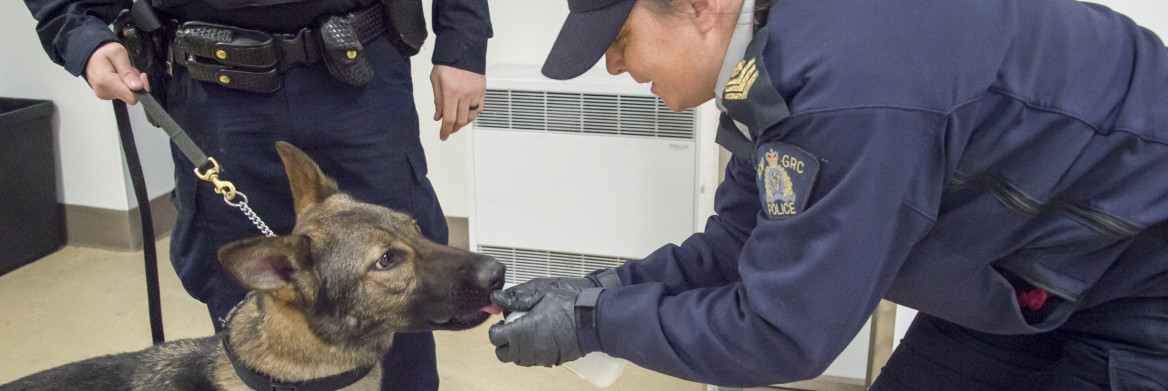Related link
Handlers with the RCMP's Police Dog Services unit spend years preparing themselves and their canine partners physically and mentally for the rigours of police work. It's a commitment to training that never stops.
Preparations are constant and fluid because when a team is called to search for a missing person or for drugs, no two situations are the same.
"There is not a 100 per cent safe way to do police work. We're exposed to different stuff all the time and knowledge is power when it comes to dealing with things,
" says S/Sgt. Gary Creed, senior trainer at the the RCMP Police Dog Service Training Centre (PDSTC) in Innisfail, Alta. — about 140 kilometres north of Calgary.
That philosophy has never been more relevant with the emergence of the dangerous synthetic opioid fentanyl. The drug has challenged law enforcement agencies because of increased seizures and fatal overdoses. As well, in 2016, several police officers were exposed to the drug.
Sniffing out fentanyl
Because it's also a threat to dogs, Creed started asking a few years ago if there was a way dogs could sniff out the powder-like substance without putting themselves and their handlers at risk. As a former explosives dog handler, he knew accommodations were made in that training so the animals could safely detect bombs.
So after brainstorming with Sgt. Eric Boechler, of B.C.'s Federal Serious Organized Crime Section, they determined the answer was yes and, last year, the RCMP developed and tested what would become an award-winning technique to detect fentanyl.
First, clandestine lab technicians combined two milligrams of pure fentanyl with 125 mg of distilled water and then placed 10 drops of the compound on a swath of cloth — something that resembled a make-up pad. Three dogs were involved in the initial testing and Creed admits, "we were prepared for the worst-case scenario.
" Medical and veterinary personnel were on site in case something went wrong.
"We didn't know what we were up against and we had to make sure they were smelling fentanyl, and that's what they were detecting,
" he says.
Some real-world proof the training worked came a couple of months later in Vancouver when, during a traffic stop, one of the original three dogs found thousands of fentanyl pills in a car.
"Now we actually had an operational case that proved the dogs were able to detect the fentanyl,
" says Creed, who notes all handlers possess the antidote — naloxone.
In November 2017, the PDSTC rece-ived an award for its fentanyl-detection work at the 2017 Homeland Security Awards in the United States.
Training and sacrifice
It takes years to train police service dogs. When they are less than one year old, German Shepherd pups are sent to live with handlers, or potential handlers, to be trained and to become accustomed to living in a community. There are repeated trips to the PDSTC for more intense training and once they are full-fledged members, the dogs are re-certified, or validated, annually.
None of it could happen without one crucial element — family support.
"Any individual who wants to join the Police Dog Service in the RCMP should know its's a lifestyle and family has to be on board,
" says Sgt. Dave McClarty, program manager with Police Dog Services in Saskatchewan. "It'd be very difficult if a person's family wasn't.
"
Cpl. Fraser McInnis, who works with his canine partner Axel on Newfoundland's west coast, sacrificed time with his two young boys to complete and continue his training. He was away from home when both of his sons were infants.
"I wouldn't be able to do it without my wife,
" he says. "You know, you miss birthdays and on Christmas Day (2017) I was called out for a missing hunter. But when you get that call, you've got to put things down and go.
"
Axel, like McClarty's police service dog Denver and all RCMP dogs trained to identify drugs, have received the training to detect fentanyl.
"These are dogs that are already trained up. It took them a day to learn the brand new smell of fentanyl and to respond positively,
" says Creed. "I don't know how stinky fentanyl is, because I've never been brave enough to smell it, but it must be because it seems like it's really easy for the dogs to find.
"
